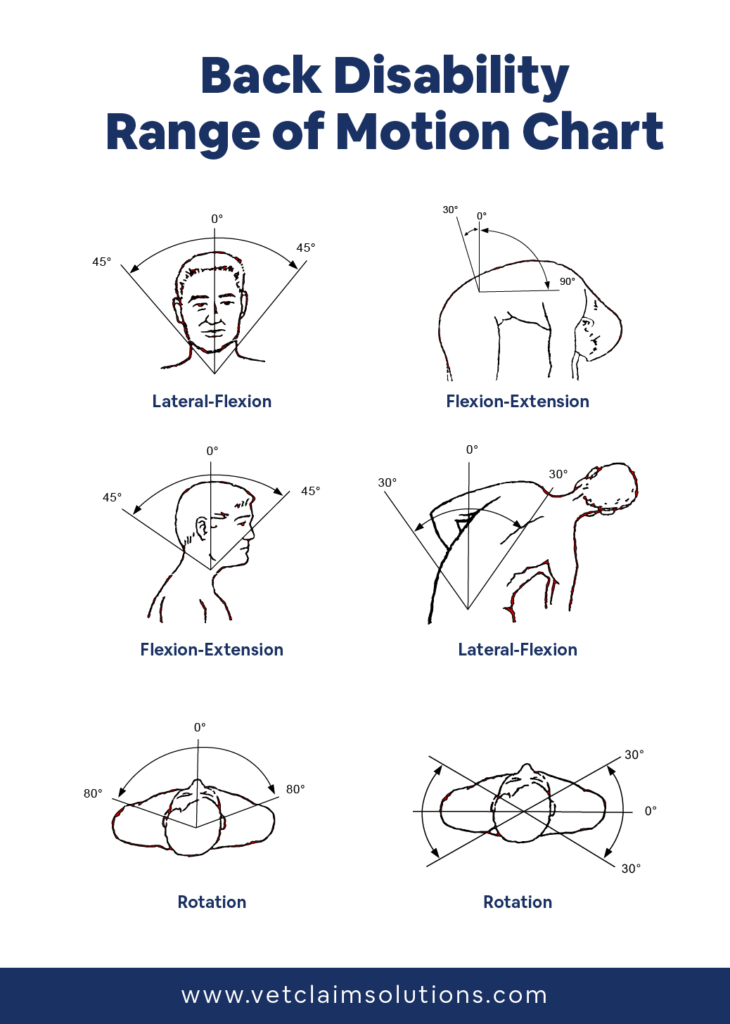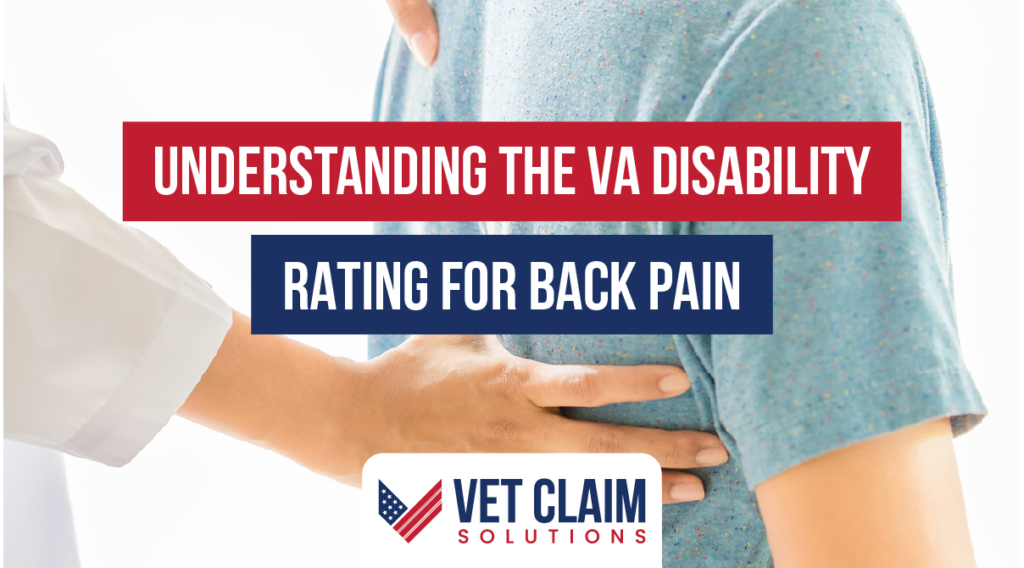Back pain is one of the most common disabilities that affect veterans. The severity of a veteran’s back pain can be rated by the Department of Veterans Affairs (VA) according to their disability rating system.
The VA evaluates veterans’ medical evidence and assigns a disability rating based on the impairment they experience due to their back pain. Understanding how this process works is essential for veterans seeking to receive benefits or compensation from the government for their condition.
This article will provide an overview of the VA’s disability rating system and explain how it applies specifically to back pain-related disabilities.

What is VA Disability Rating for Back Pain?
VA disability rating for back pain is a system of evaluating medical evidence to assign a disability percentage that reflects the impairment a veteran experiences due to their condition.
The VA assigns a specific percentage, ranging from 10% to 100%, depending on the severity of the disability as determined by their medical evaluation. This percentage is then used to determine how much compensation and benefits a veteran can receive from the government.
VA Disability Rating For Back pain Explained:
VA disability rating for back pain can be a complex and confusing process. To best understand the system, it is important to be familiar with the different ratings and how they affect veterans’ eligibility for compensation or other benefits. The VA typically uses the General Rating Formula for Diseases and Injuries of the Spine under 38 CFR § 4.71a to evaluate and assess low back pain.

A 100% VA disability rating for back pain is assigned when there is unfavorable ankylosis of the entire spine. This means that the spine has become so fused that it can no longer perform its normal functions. At this level, a veteran is likely to experience extreme pain and other symptoms related to their disability.

At a 50% VA disability rating for back pain, unfavorable ankylosis of the entire thoracolumbar spine is present. This means that the spine is fused between the ribs and hips in the middle section. The veteran may experience discomfort and stiffness in their back due to this.

A 40% VA disability rating for back pain is assigned when there is unfavorable ankylosis of the entire cervical spine, or forward flexion of the thoracolumbar spine is less than or equal to 30 degrees. This means that the spine is fused in the neck or that movement in the middle section of the back is limited.

At a 30% VA disability rating for back pain, forward flexion of the cervical spine is greater than 15 degrees but not greater than 30 degrees. This means that the neck can bend, but there is still some limitation in movement. Alternatively, favorable ankylosis of the entire cervical spine is also recognized at this level.

At a 20% VA disability rating for back pain, forward flexion of the thoracolumbar spine can be greater than 30 degrees but not greater than 60 degrees. This means that movement in the middle section of the back is somewhat limited. A combination range of motion of the thoracolumbar spine not greater than 120 degrees and a combined range of motion of the cervical spine not greater than 170 degrees are also recognized at this level.

A 10% VA disability rating for back pain is assigned when forward flexion of the thoracolumbar spine is greater than 60 degrees but not greater than 85 degrees. This means that the movement in this back section is somewhat limited. Other conditions recognized at this level include forward flexion of the cervical spine greater than 30 degrees but not greater than 40 degrees, combined range of motion of the thoracolumbar spine greater than 120 degrees but not greater than 235 degrees, combined range of motion of the cervical spine greater than 170 degrees but not greater than 335 degrees, muscle spasm, guarding, or localized tenderness not resulting in abnormal gait or abnormal spinal contour, and vertebral body fracture with loss of 50 percent or more of the height.
Who Qualifies for VA Disability Rating for Back Pain
To qualify for a VA disability rating for back pain, veterans must be able to demonstrate that their condition is directly related to an injury or illness that occurred during active duty military service. This is what is known as a direct service related condition.
Another approach that a veteran can use to connect back pain is through the secondary service-connected argument in which a condition that a veteran is already rated for has caused or made worse a new condition. for example, a veteran is rated for bi-lateral knee strains. Over time the knee condition has impacted the veteran’s back causing him/her to develop a back problem.
Regardless of which tactic the veteran uses to connect back pain, the veteran’s medical records must reflect evidence of the diagnosis and treatment of their condition.
Furthermore, the veteran must show how their back pain has caused them to experience a decrease in their quality of life. Conditions that commonly qualify for a VA disability rating for back pain include lumbosacral strain, spinal stenosis, vertebral fracture or dislocation, and spinal fusion.
Depending on the severity of the condition and its associated symptoms, veterans may be eligible for various ratings, ranging from 10% to 100%. In order to determine an appropriate rating, the VA considers such factors as the type of injury, its location and degree of impairment, range of motion in affected areas, and any associated musculoskeletal disabilities.
How to file the VA disability claim for back pain
To successfully file a VA disability claim for back pain, veterans must be able to provide evidence of three main components.

1) Medical diagnosis
Firstly, they need to provide a current diagnosis of the condition they are filing a claim for from a medical professional. This diagnosis should be up-to-date and describe any relevant symptoms or associated conditions, such as spinal cord injury.
2) In-service event
Secondly, veterans must provide evidence of a service-connected event that caused or aggravated their back pain. This can include an in-service injury, illness, or exposure to hazardous substances during active duty service.
3) Medical Nexus
Thirdly, there needs to be a way to connect the back pain to time in service. If connecting via direct service, the evidence in the veteran’s service treatment records (STRs) is usually enough to establish service connection. However, at times a formal nexus letter may be needed to argue the service connection especially if going after the back pain as secondary to an existing rated condition.
Once all the evidence has been collected and submitted, along with attending a C&P exam, veterans will receive a disability rating from the VA. This rating is usually expressed as a percentage, determining the compensation they are eligible to receive.
Available VA Benefits for Back Pain
Veterans suffering from pain in their lower back may be eligible for VA benefits depending on the severity of the disability. The VA assigns a disability rating based on how your lower back pain affects your ability to work. Depending on the rating, veterans may receive anywhere from a few hundred to a few thousand dollars monthly in compensation.
TDIU Benefits for Pain in the Lower Back
Total disability based on individual unemployability (TDIU) is available to veterans whose lower back pain prevents them from working. When approved, TDIU benefits are paid at a 100 percent disability rate, providing veterans with additional financial support.
Conclusion
VA disability benefits for back pain can be complex and confusing, but veterans must understand the process to receive the financial assistance they need. With the right evidence and preparation, veterans can successfully file a claim for back pain disability benefits. Additionally, understanding the available benefits can help them make the most of their situation.
FAQ’s

What is the average VA disability rating for back pain?
The average VA disability rating for back pain is between 10% and 30%. However, ratings can vary depending on the severity of the condition and associated symptoms.

What type of back problems qualify for VA disability?
common types of back injuries that can qualify for VA Disability include Lumbosacral strain, Spinal stenosis, Vertebral fracture or dislocation, and Spinal fusion.

How do I get a higher VA rating for back pain?
To receive a higher VA rating for back pain, veterans must prove service connection. This can be done by providing medical evidence of a current disability due to an injury or illness that occurred while on active duty, tracing the injury or illness back to an event during service, and/or showing a link between current symptoms and an event in service. In addition, veterans may also need to provide proof of treatment for back pain and/or a nexus letter from a medical expert linking their current disability to an in-service event. If the evidence is sufficient, VA can then evaluate the disability and assign a rating. The higher the rating, the more veterans receive VA disability benefits



This Post Has One Comment
Very nice post. I just stumbled upon your blog and wanted to say that I’ve really enjoyed browsing your blog posts. In any case I’ll be subscribing to your feed and I hope you write again soon!